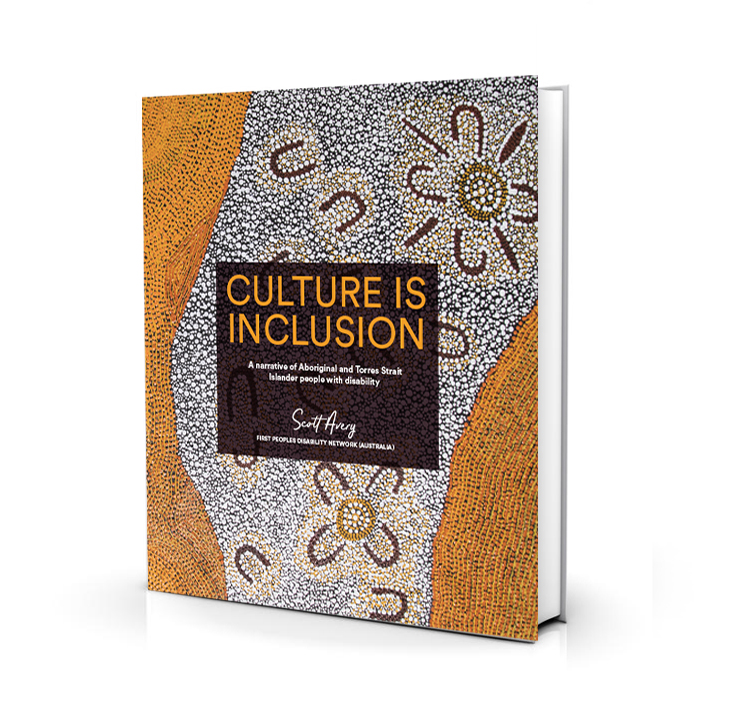Culture is inclusion: A narrative of Aboriginal and Torres Strait Islander Disability
Culture is Inclusion is an outcome of a research project that promotes the voices of Aboriginal and Torres Strait Islander people with disability within research and policy. The research project is an exploratory study into the issues that affect Aboriginal and Torres Strait Islander people with disability, as told by them through their testimony.
Led by the First Peoples Disability Network it creates a ‘narrative’ of Aboriginal and Torres Strait Islander people with disability by combining their personal testimony gathered through interviews with statistical data sourced from Australian Bureau of Statistics. This data is brought to life with the distinctly Aboriginal concept of ‘yarning’, where vignettes are extracted from the testimony to show how many issues come together in the daily life of one person. The research is presented in ten chapters.
Chapter 1 introduces the cultural and social background to the research. It entails a brief history of inclusion and disability in Indigenous cultures going back to ancient times. It then provides a snapshot on the impact of colonisation from a disability perspective. It concludes with the emergence of the rights based movement to draw attention to the marginalization of Aboriginal and Torres Strait Islander people with disability in Australian society.
Chapter 2 outlines the key concepts and terms used throughout the research. It includes definitions for the use of some common terms within this research. It conceptualises how the ‘narrative’ was developed, by integrating the testimony from interviews with participants, statistical data, and ‘yarnings’. It establishes a vocabulary of new concepts where existing terminology could not adequately explain the experiences of Aboriginal and Torres Strait Islander people with disability. ‘Intersectional inequality’ and ‘apprehended discrimination’ are two concepts that have been described in this chapter, and are used in later chapters to explain the research.
Chapter 3 builds on the conceptual model of community-directed research by outlining how the principles for participatory research were put into research practice. It describes the role of an Academic Advisory Panel providing academic guidance on the conduct of the research. It then discusses a relational approach with the Australian Bureau of Statistics in securing technical advice on the statistical data that was used in the research, and outlines the factors that have made this relationship a benchmark of engagement between an Aboriginal and Torres Strait Islander community organisation and a government agency.
Chapter 4 commences the presentation of the research findings. This chapter presents the statistical data on the prevalence and profile of disability in the Aboriginal and Torres Strait Islander population. It also draws upon the testimony of research participants for a focussed discussion of issues that emerged from the statistical data analysis. These issues include: the availability of disability diagnoses in Aboriginal and Torres Strait Islander communities; the ‘overshadowing’ of co-occurring disability; and the intersection of gender and remoteness in Aboriginal and Torres Strait Islander disability data.
Chapter 5 exposes the discrimination faced by Aboriginal and Torres Strait Islander people with disability attributable to racism, ableism and a unique form of ‘intersectional discrimination’. Using illustrative quotes from the testimony of participants, it explores the concept of ‘apprehended discrimination’ to describe the pathway in which an expectation of discrimination can lead people into avoiding situations where they might be exposed to discrimination.
Chapter 6 is an analysis of the social, health and wellbeing inequalities experienced by Aboriginal and Torres Strait Islander people with disability. The statistical data and participants’ testimony have been presented thematically and organised according to the priorities of the Australian Government’s National Plan to Improve Outcomes for Aboriginal and Torres Strait Islander People with Disability.
Chapter 7 is dedicated to the implementation of the National Disability Insurance Scheme (NDIS) in Aboriginal and Torres Strait Islander communities. Whilst implementation of the NDIS in Aboriginal and Torres Strait Islander communities was in its formative days when this research was conducted, several concerning issues emerged that warrant a further focussed investigation.
Chapter 8 details the staggeringly high detrimental impact that accumulated experiences of discrimination, trauma and social exclusion have on the mental health and wellbeing of Aboriginal and Torres Strait Islander people with disability. It can make for difficult reading, even harder for the people living it. But within the testimony, there still glows embers of hope.
Chapter 9 shifts the tone from social exclusion to a culture of inclusion. It presents a crucial finding of the research: that despite the inequalities experienced in other aspect of their life, Aboriginal and Torres Strait Islander people with disability participate in community and cultural activities at the same rate as other Aboriginal and Torres Strait Islander people. It discusses the implications of a ‘culture of inclusion’ as a moderating force on the health and wellbeing of Aboriginal and Torres Strait Islander people with disability, and prescribes a model for inclusive policy and practice.
Chapter 10 brings the themes and issues discussed in the previous chapters together to form a concise First Peoples disability research agenda and a direction for further research activity and policy development. This is the ultimate deliverable for the research project and its concluding recommendation.

